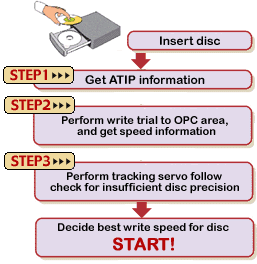Eleven 20x/24x CD Burners
The Right Speed For The Right Results
The first manufacturer to introduce burner/blank media adaptation technology was Yamaha, with Optimum Write Speed Control. With this technology, the burner uses a short test to recognize the type and capacities of the medium used, and adjusts the maximum write speed accordingly - even while recording is in progress. This technique helps to minimize the number of errors on a burned CD. The operation is a hardware one and must be done every time a new blank CD is used. It can be disabled in most software to gain time and prevent the write speed from being slowed, if need be.
PoweRec-II by Plextor and FlexSS-BP by Sanyo work in the same way, but only check the medium at the moments when the Z-CLV mode stops running. This means the burner does an OPC (Optimum Power Control) at the start of the operation, then another one after 6 minutes of CD time to check that the medium really can handle speeds over 20x, and again at 16 minutes, for 24x.
JustSpeed by Ricoh is a more advanced form of this kind of system because it combines an OPC with a hardware database of the most usual types of CD-R. The burner scrutinizes the CD-R's ATIP (Absolute time in Pre-groove), and analyzes the type of layer, the manufacturer and certified speeds (if given), and adjusts itself accordingly, based on what the database tells it to do. It then runs a more practical check - an OPC - and a final one to synchronize the reading head with the data groove to keep errors to a minimum. This is a far-reaching method which should give the most consistent results, even though it doesn't run a check during the recording operation. Phillips' Thermo Balanced Writing works in the same way, except that it has no hardware database, using what they call a "smart algorithm" instead, which adjusts the write head to the CD-R used.
Get Tom's Hardware's best news and in-depth reviews, straight to your inbox.

